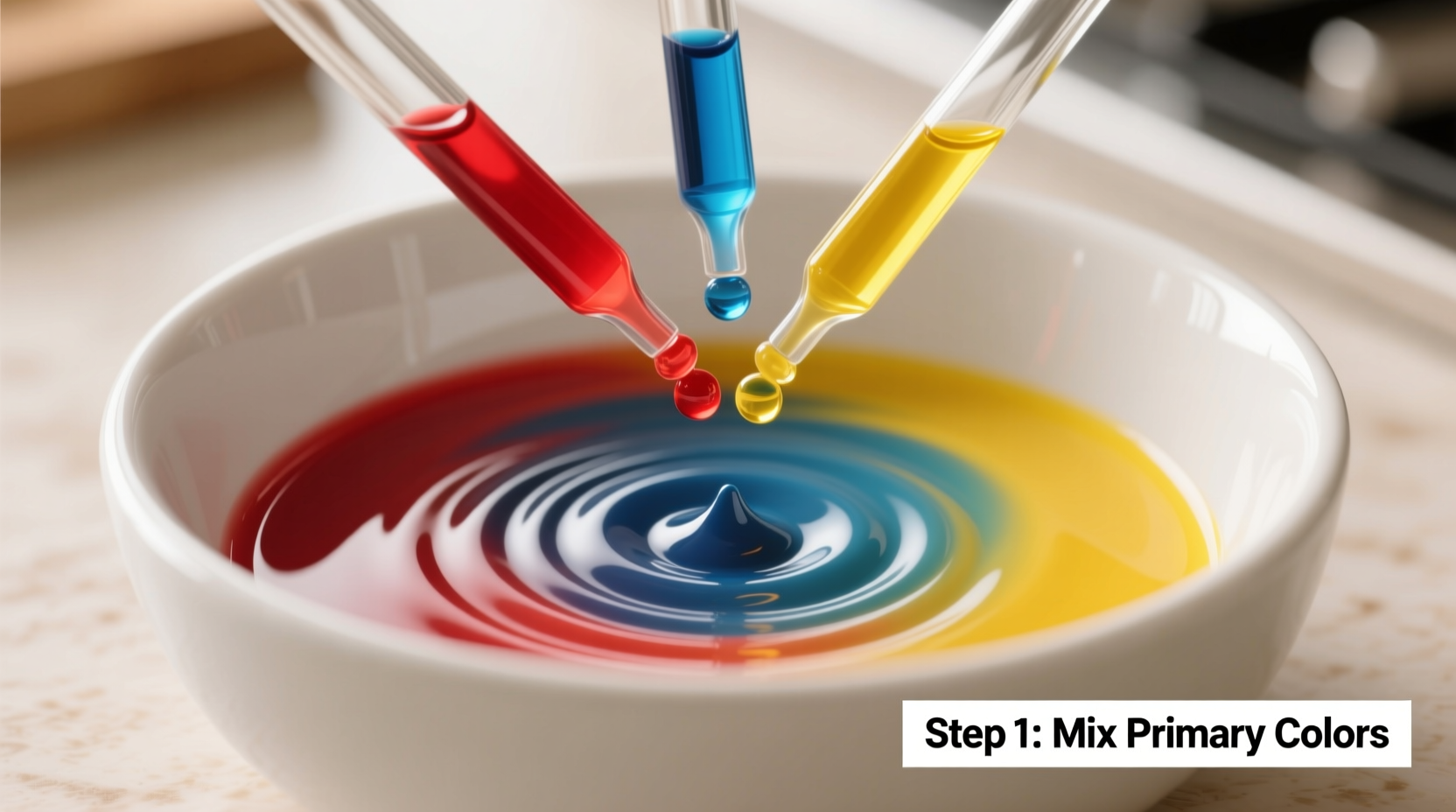The Science Behind Creating Perfect Brown Hue
Creating brown food coloring might seem counterintuitive since it's not typically sold as a standard color. Unlike primary colors, brown is a tertiary color formed by mixing complementary colors that cancel out each other's vibrancy. When working with food coloring, understanding this color theory principle prevents common mistakes like ending up with green instead of brown.
| Color Type | Basic Ratio (Red:Yellow:Blue) | Best For |
|---|---|---|
| Standard Brown | 3:2:1 | Cookie dough, light sauces |
| Chocolate Brown | 3:1:2 | Chocolate frosting, cake batters |
| Tan/Light Brown | 2:3:1 | Caramel sauces, light pastry creams |
Step-by-Step Mixing Process
Follow this precise method to achieve consistent brown shades every time:
- Start with your base - Prepare your frosting, batter, or medium where you'll incorporate the color
- Begin with yellow - Add 2 drops of yellow food coloring per cup of base mixture
- Incorporate red - Add 3 drops of red food coloring, mixing thoroughly after each addition
- Add blue gradually - Introduce 1 drop of blue food coloring, mixing completely before assessing
- Adjust incrementally - If too red, add more blue; if too green, add small amounts of red
- Wait and evaluate - Colors deepen over 15-30 minutes, so allow time before final adjustments

Working with Different Food Coloring Types
The type of food coloring you use significantly impacts your results. Professional bakers recommend gel-based colors for brown shades because they're more concentrated and won't alter your recipe's liquid balance.
Liquid vs. Gel Comparison:
- Liquid food coloring requires more drops to achieve intensity, potentially thinning batters
- Gel food coloring provides vibrant results with minimal quantity (1/4 teaspoon often suffices)
- Natural alternatives like cocoa powder create brown but affect flavor and texture
Application-Specific Formulas
Not all brown is created equal. Different culinary applications require specific shade adjustments:
For Chocolate Frosting
Use a 3:1:2 ratio (red:yellow:blue) with gel coloring. Add 1/4 teaspoon of black gel if you need an extra-dark chocolate appearance. Remember that cocoa powder already provides some brown base, so you'll need less coloring than with vanilla bases.
For Meat-Like Colors (Vegan Cooking)
Create realistic meat tones with a 4:1:1 ratio, then add a tiny drop of green to neutralize excess redness. This technique works particularly well for vegan "ground beef" alternatives using lentils or mushrooms.
For Cookie Dough
Since cookie dough lightens during baking, create a slightly darker brown than desired. Use 3 drops red, 2 drops yellow, and 1.5 drops blue per cup of dough. The heat will mellow the color to perfection.
Troubleshooting Common Issues
Even experienced bakers encounter color challenges. Here's how to fix the most frequent problems:
- Brown turned green - You've added too much blue relative to red. Counteract by adding small amounts of red food coloring until the green tone disappears.
- Color too intense - Gradually incorporate more of your base mixture (frosting or batter) to dilute the color without altering consistency.
- Color faded after baking - Some colors degrade with heat. For baked goods, create a slightly darker shade than desired, as colors typically lighten by 20-30% during baking.
- Inconsistent coloring - Ensure thorough mixing; food coloring can settle. Mix for at least 2 minutes after final color addition.
Advanced Color Matching Techniques
Professional pastry chefs use these expert methods for precise color replication:
When matching a specific brown reference (like a chocolate bar wrapper), work in a well-lit area and compare against a white background. Create small test batches with incremental adjustments rather than modifying your entire mixture. The FDA's Center for Food Safety and Applied Nutrition notes that food coloring concentrations must remain within approved limits, so always use the minimum amount necessary to achieve your desired shade (fda.gov/food/color-additives).
For natural alternatives, consider that cocoa powder creates a brown hue but significantly alters flavor. A study published in the Journal of Food Science found that turmeric combined with beet juice can create brown tones, though the flavor profile changes substantially compared to artificial coloring.
Preserving Color Integrity
Brown food coloring can change over time due to light exposure and ingredient interactions. Store colored products away from direct sunlight, as UV rays degrade food dyes. The American Association of Baking recommends using colored items within 24-48 hours for optimal color retention, especially with lighter brown shades that are more prone to fading.











 浙公网安备
33010002000092号
浙公网安备
33010002000092号 浙B2-20120091-4
浙B2-20120091-4